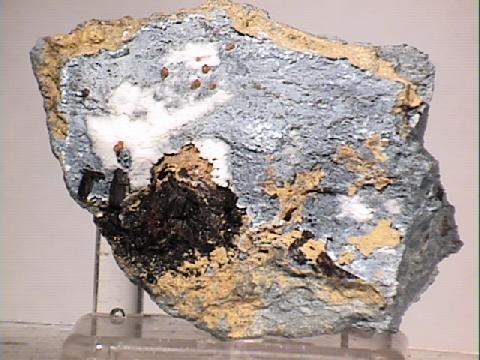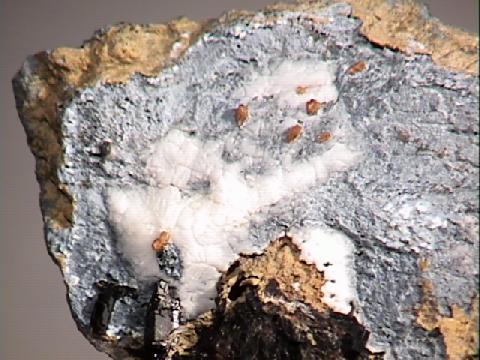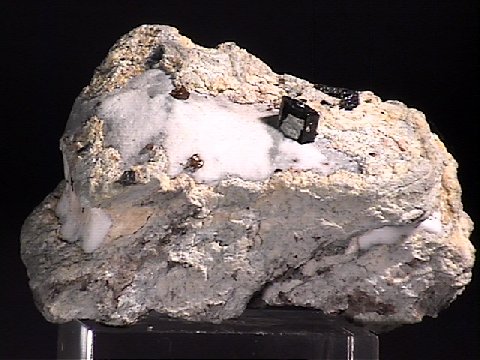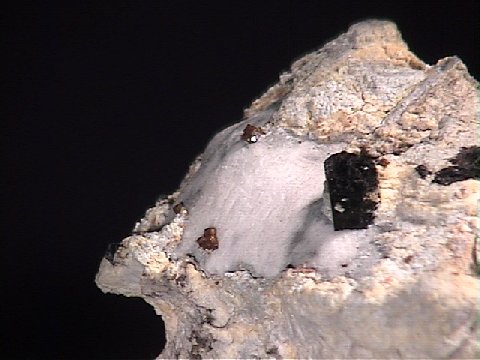 THE MINERAL JOAQUINITE-(Ce)
THE MINERAL JOAQUINITE-(Ce)
- Chemistry: NaBa2FeCe
2(Ti, Nb)2(SiO3)
8O2(OH, F) - H2O,
Hydrated Sodium Barium Iron Cerium Titanium Niobium Silicate Oxide Hydroxide Fluoride - Class: Silicates
- Subclass: Cyclosilicates
- Group: Joaquinite
- Uses: Only as a mineral specimen
Specimens
Joaquinite is a product of some very unusual hydrothermal solutions. These solutions contained the elements titanium, niobium, lithium, barium, niobium, manganese, fluorine, cerium and several others. Anyone of them by themselves is not that unusual, but together in one solution and in such high concentrations is quite unusual. How they came to be combined like this is not yet well understood, but their product of unusual silicate minerals is much appreciated.
Joaquinite lends its name to a group of similar minerals.
The Joaquinite Group members are unusual cyclosilicate minerals.
They are some of only a few four membered ring silicates.
These silicates have four silicate tetrahedrons linked into a ring forming a distorted square-like structural element.
The general formula of this group is
A6(Ti, Nb)2Si8(O, OH)6 - H2O;
where A can be either sodium, barium, cerium, iron, manganese and/or strontium.
Joaquinite and strontiojoaquinite are monoclinic, while the other members are orthorhombic.
These are the members of the Joaquinite Group:
Bario-Orthojoaquinite (Hydrated Barium Strontium Iron Titanium Silicate Oxide Hydroxide)Byelorussite-(Ce) (Hydrated Sodium Barium Cesium Lanthanum Manganese Titanium Silicate Fluoride Hydroxide)- Joaquinite (Hydrated Sodium Barium Iron Titanium Niobium Cerium Silicate Oxide Hydroxide Fluoride)
Orthojoaquinite (Hydrated Barium Sodium Cesium Iron Titanium Silicate Oxide Hydroxide)Strontiojoaquinite (Hydrated Strontium Barium Sodium Iron Titanium Silicate Oxide Hydroxide)Strontio-orthojoaquinite (Hydrated Strontium Barium Sodium Iron Titanium Silicate Oxide Hydroxide)
PHYSICAL CHARACTERISTICS:
- Color is brown, orange-brown, yellow or honey-yellow.
- Luster is vitreous to silky.
- Transparency: crystals are transparent to translucent.
- Crystal System is monoclinic.
- Crystal Habits include small equant stubby or striated bladed crystals often scattered on the host rock.
- Cleavage is not seen.
- Hardness is 5 - 5.5
- Specific Gravity is approximately 3.8 - 4.0 (above average for transparent minerals)
- Streak is white.
- Associated Minerals include the sapphire blue benitoite, the red-black neptunite, the snow white natrolite and massive green serpentine as well as microcline, quartz and aegirine.
- Notable Occurrences include the Joaquin Ridge (hence the name), Mt. Diablo Range, Contra
Costa County and the head waters of the San Benito River,
San Benito County , California, USA and a few rare specimens have been found at Mont Saint-Hilaire, Quebec, Canada. - Best Field Indicators are crystal habit, associations, color and locality.









